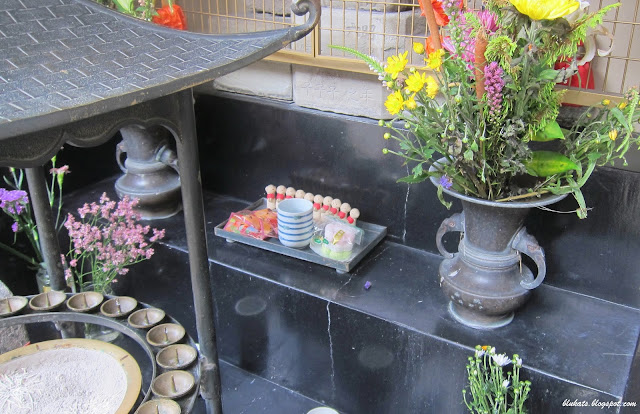Even though there are a number of interesting things to see in Ningyocho and that it's an area of historical cultural importance, it's difficult to find much in English about some the sights there like the Buddhist temple Dai Kannon Ji.
I came across Dai Kannon Ji, also known as Okannonji, while wandering around one morning. Curious, I looked around and took a few photos. Like these colorful banners which might be prayer flags.
Because land is expensive in Tokyo many shrines are on small parcels like this one. Interesting that even though it's not on a hill they still have stairs to walk up to it. Unless one is paying attention it would be easy to miss that it's even there. But once I walked up I could see the many different objects there like this chōzubachi (手水鉢) used for ritual washing of practitioners' hands and mouth. The marking on this one indicates it's for a Buddhist temple.
Since this is a Bodhisattva Kannon temple it's not surprising to see a number of Jizo statues since both are related to easing suffering along with other similar duties. The shrine for the Jizo is very well attended.
Both Kannon and Jizo are associated with salvation and safety of children and this shrine reflects that. Parents give prayers and offerings for their children both born and unborn.
This is the first Jizo shrine where I have seen people leaving prayer papers.
The colors of the bell pull are interesting also. Usually they are made of plain rope.
There were even ten tiny Jizo on the offering tray. I am not sure if this is related to the ten judges of hell. They are related to Jizo's role in delivering people from the torments of hell. Ten Jizo would help with defending from the ten judges.
I'm not sure what the scrub brushes are about. Perhaps it's symbolic for cleaning one's sins? This shrine isn't that big but there is a lot going on.
Even though at one time the Government separated the Shinto religion from Buddhist religion, Shinto shrines can still be found at Buddhist temples. Interesting that this Shinto Inari shrine is right at the chōzubachi and is attached to the side of the Jizo shrine. Trying to save space I suppose.
This is a very small Inari shrine with the kitsune fox statues behind glass. Usually there are at least two outside of the actual shrine. People worship Inari for prosperity. There is also a statue of Inari or possibly Dakini-ten riding the kitsune in the middle under the tiny torii.
This is the main building at this small temple. To the side of this building is a small black statue with three heads and eight arms which may represent Bato Kannon. The faces are angry and he is holding an ax in one hand, a sword in another and a flute. Bato Kannon is considered a protector of horses. Sadly my photo did not turn out well due to glass in front of the statue. Interesting to see it.
In this hall is a large cast iron head of Tetsuzo Bodhisavatta, a Buddhist saint. It is only on view a few days each year so I did not see it although in photos it is really large. What little information I could find in English is from this website that says it was dug from a well in the Edo era. The head was enshrined here in 1876, however the temple may have been built in 1880. The size of the head is a total of 170 cm and was previously in Kamakura before being brought here (per Japanese websites).
What I also found out is that they have doll memorial services here along with this temple being the third stop of the 33 Buddhist Temple Pilgrimage which dates back to Edo times.
What I also found out is that they have doll memorial services here along with this temple being the third stop of the 33 Buddhist Temple Pilgrimage which dates back to Edo times.
There is a large incense burner. Incense is used to clear the mind and some believe that by wafting it over one's self it can help heal the body.
There are two of these at the main hall. Possibly they have lit candles in them? If so they must be quite striking to see when in use.
Also very beautiful were the lanterns decorated with what appears to be stylized irises.
I wish I had more information about Dai Kannon Ji Temple. With so many temples and shrines in Japan, it's difficult for them to document all of them and then trying to put that information in another language. It was a bit of work to find what I did find. I hope it helps make the photos more interesting.
















No comments:
Post a Comment